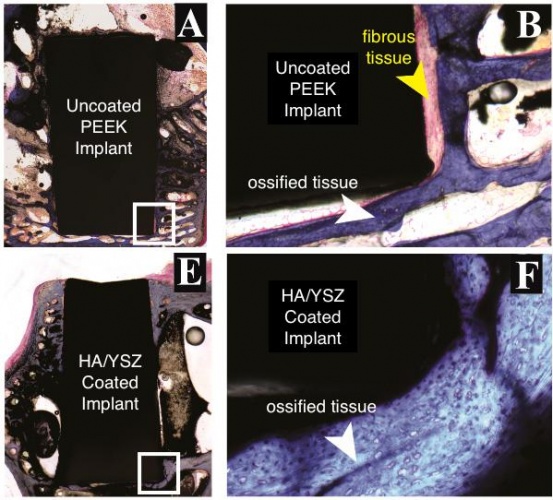The process, developed in partnership with Cambridge University and the University of Texas at San Antonio, involves coating polymer implants with a bioactive film. Testing was carried out on a polymer called polyether ether ketone, or PEEK, which is used in implants due to its similar mechanical properties to bone. PEEK itself doesn’t bond well with bone however, and this is what drove the study, published this week in Materials Science and Engineering.

Previously, PEEK had been coated with hydroxyapatite (HA), a calcium phosphate that promotes osteobonding.However, the HA coating could only be applied to flat surfaces and had never been tested on an implant in a living creature.
"We can now use our technique to coat the entire surface of an implant, and testing HA-coated implants in an animal model has given us very promising results," said Afsaneh Rabiei, a professor of mechanical and aerospace engineering at NC State.
The first step of the process involves coating the PEEK implant with a thin film of yttria-stabilised zirconia (YSZ). A layer of HA is then applied, which is heated using microwaves. During this heating, the YSZ layer acts as a shield that protects the PEEK from melting. The heat also gives the HA a crystalline structure that makes it more stable in the body, meaning that the calcium phosphate will dissolve more slowly, which promotes bonding with surrounding bone.
Testing HA coated implants in rabbits, the researchers found that 18 weeks after surgery, implants with the bioactive film had double the bone formation of non-treated PEEK. The HA-treated implants also had higher bone-to-implant contact ratios than PEEK alone.
"These results indicated an improved implant fixation in the body, decreasing the chances of loosening of the implant after surgery and the need for revision surgery to remove and replace the implant," Rabiei said. "This improvement is due to increased regenerated bone volume around coated implants compared to uncoated PEEK."
The researchers also assessed the durability of the implants using a technique called biomechanical push-out testing. HA-coated implants required about 40 per cent more force to dislodge.
"Whether looking at bone growth or toughness, HA-coated samples outperformed uncoated PEEK implants," said Rabiei. "This treatment will probably increase the cost of an implant marginally, but should help minimise the need for follow-up surgeries - which means HA-treated implants will more than pay for themselves over time."
As YSZ and HA are already in medical use, the coated implants may not require full clinical trials. According to Rabiei, the team is now looking for industry partners to help commercialise the technique.





Nanogenerator consumes CO2 to generate electricity
Whoopee, they've solved how to keep a light on but not a lot else.